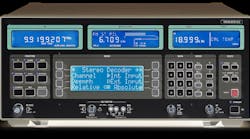Frequency hopping is a method that’s commonly utilized to help avoid interference and increase security. Since data throughput is a key parameter for wireless systems, an important metric is the time needed for a frequency change or hop. Frequency-settling-time measurements are therefore essential for frequency synthesizers. In the application note, “Frequency and Phase settling time measurements on PLL circuits,” Rohde & Schwarz provides an overview of these types of measurements, followed by an explanation of how such measurements can be performed with modern phase-noise analyzers.
Since a frequency hop impacts data throughput, its execution time is limited. Understandably, then, quick frequency settling is a key characteristic. Furthermore, complex test setups have been required to determine the settling time of a frequency hop. The application note points out, though, that communication-system developers now require an easy and efficient method due to time pressures.
The document next presents some theoretical information. Frequency settling is typically measured during the development of components for modern communication applications, such as mobile phones and radar systems. It can be quantified as the time needed to hop from one frequency to another. Only after settling on the new frequency can data transmission begin.
In most communication systems, the internal frequency oscillators are frequency-locked to a common frequency reference via a phase-locked loop (PLL). The PLL’s loop filter greatly affects the amount of time required by the system for frequency and phase settling after a frequency or channel change.
While past frequency-settling-time measurements involved a frequency discriminator, an alternative method involves signal analyzers with digital sampling. High-speed analog-to-digital converters (ADCs) can sample an input signal and then save the measurement data. The bandwidth and sampling rate of the ADCs, along with the available memory, determine the acquisition time, possible frequency resolution, and the range at which frequency settling can be measured.
Also discussed in the document is how modern phase-noise analyzers can measure frequency- and phase-settling time. It wraps up by revealing measurements performed with the FSWP phase-noise analyzer.
Rohde & Schwarz, Mühldorfstrasse 15, 81671 Munich, Germany; (888) 837-8772

